
University of Kentucky Department of Entomology







Paper Mache Insectsby Stephanie Bailey,
| ||||||||||||||
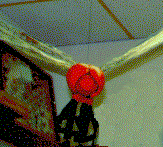 S. Bailey 1995 | Painting is the main way to decorate the insect's body, and can be as simple or detailed as the artist wants. Besides paint, other body decorations might include glitter-painted or nerf-ball eyes, feather or pipe cleaner antennae, party favor or pipe cleaner mouthparts, and cut up coat hanger wires or pipe cleaner legs, etc. as imagination allows. With a little creativity, these bugs will look amazingly real! |
The final touch is the wings. Overhead projectors allow easy enlargments of illustrations to the size needed. Have students use ratios to determine what size enlargement of illustrations or specimens is needed by measuring the length of the body in the picture compared with the paper mache body, and calculate the length of wings that will give the correct ratio for the size of wings in the picture or specimen.
| Transfer the projection to window insulation film (e. g. 3M brand), clear contact paper or plastic wrap for membranous (see-through) wings for dragonflies, flies, or wasps. Use crepe paper or thin fabric for butterfly, moth or grasshopper wings. Trace the wings with a permanent marker or pen (temporary or water-soluble markers won't work on the plastic). | 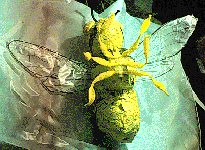 S. Bailey 1995 |
Finally, use coat hanger wire or something a little thinner (florists' wire is too thin), shaped and glued to the outer margins of the wings to give the wings the rigidity they need. Finally, hot glue the inner wire portion of wings to the body. Regular glue will not hold them. With very heavy wings, you may have to cut a notch in the body wall for extra glueing surface area.
Extra hints:
For butterflies or moths use colored feathers for the bodies (moths especially are very hairy). Long feathers make great moth antennae. Use pipe cleaners for legs and (coiled up) mouthparts. Color in wing patterns with markers, fabric paints or glue cutouts of tissue paper to wings. These insects will look better if the body is no more than 2/3 the length of wings. They also look better when there is a 'notch' between front and back wings.
| Dragonflies, damselflies, mayflies, and dobsonflies all have long, thin bodies and big, membranous wings. | 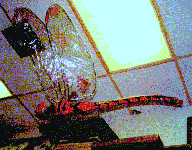 S. Bailey 1995 |
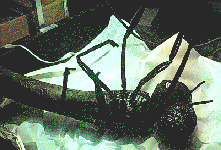 S. Bailey 1995 | Use a long, thin balloon, but build up sections for the head and thorax a bit more than the abdomen, to make it more realistic. Dragonflies and damselflies have thick legs with spines for catching prey -- use foam legs with toothpicks glued into them. |
| Mayflies look similar but have very thin legs, antennae and cerci (tails). Use twine or rope, dipped in the paper mache to stiffen them. Male dobsonflies have very large mandibles (jaws), which can be made from molding rolled newspaper in paper mache or simply cutting out foam. | |
| Praying mantises and walking sticks have thin bodies as above but walking sticks have no wings. Use pipe cleaners, twine or rope for the legs and antennae, dipped in paper mache and bend the legs to dry. Additionally, praying mantis front legs are thicker, use foam wrapped around coat hanger wire, then glue in toothpicks to look like the thick spines. | 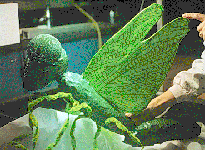 S. Bailey 1995 |
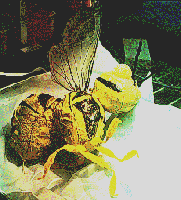 S. Bailey 1995 | Flies, beetles, bees, wasps, and bugs all would need the regular, rounded balloons. For beetles, build up the wing covers on either side of a pencil. The groove will not be too big, but will be enough to separate the wings. Toothpicks or pieces of yarn glued to the body will simulate the hairy bodies of flies. |
Use long wavy party balloons for caterpillar bodies--they're already segmented! Look up strange and wild caterpillars for models, e. g. hornworm, hickory horned devil, monarch, cecropia, spicebush swallowtail, etc. (See EntFact 003--Stinging Caterpillars and EntFact 008--Saturniid Moths--for pictures of some of these caterpillars.)
Photographs courtesy of S. Bailey, University of Kentucky Department of Entomology
Last updated: 15 January 1999
 Return to UK Department of Entomology Katerpillars page
Return to UK Department of Entomology Katerpillars page Return to UK Department of Entomology homepage
Return to UK Department of Entomology homepage Return to University of Kentucky homepage
Return to University of Kentucky homepage